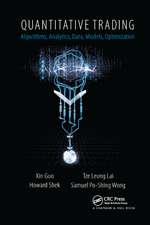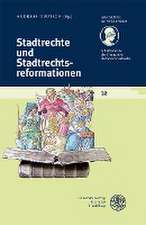Cellular Automaton Modeling of Biological Pattern Formation: Characterization, Examples, and Analysis: Modeling and Simulation in Science, Engineering and Technology
Autor Andreas Deutsch, Sabine Dormannen Limba Engleză Hardback – 10 mar 2018
This text explores the use of cellular automata in modeling pattern formation in biological systems. It describes several mathematical modeling approaches utilizing cellular automata that can be used to study the dynamics of interacting cell systems both in simulation and in practice. New in this edition are chapters covering cell migration, tissue development, and cancer dynamics, as well as updated references and new research topic suggestions that reflect the rapid development of the field.
The book begins with an introduction to pattern-forming principles in biology and the various mathematical modeling techniques that can be used to analyze them. Cellular automaton models are then discussed in detail for different types of cellular processes and interactions, including random movement, cell migration, adhesive cell interaction, alignment and cellular swarming, growth processes, pigment cell pattern formation, tissue development, tumor growth and invasion, and Turing-type patterns and excitable media. In the final chapter, the authors critically discuss possibilities and limitations of the cellular automaton approach in modeling various biological applications, along with future research directions. Suggestions for research projects are provided throughout the book to encourage additional engagement with the material, and an accompanying simulator is available for readers to perform their own simulations on several of the models covered in the text. QR codes are included within the text for easy access to the simulator.
With its accessible presentation and interdisciplinary approach, Cellular Automaton Modeling of Biological Pattern Formation is suitable for graduate and advanced undergraduate students in mathematical biology, biological modeling, and biological computing. It will also be a valuable resource for researchers and practitioners in applied mathematics, mathematical biology, computational physics, bioengineering, and computer science.
PRAISE FOR THE FIRST EDITION
“An ideal guide for someone with a mathematical or physical background to start exploring biological modelling. Importantly, it will also serve as an excellent guide for experienced modellers to innovate and improve their methodologies for analysing simulation results.” —Mathematical Reviews
Din seria Modeling and Simulation in Science, Engineering and Technology
-
 Preț: 410.88 lei
Preț: 410.88 lei - 18%
 Preț: 958.38 lei
Preț: 958.38 lei - 18%
 Preț: 784.13 lei
Preț: 784.13 lei - 15%
 Preț: 551.02 lei
Preț: 551.02 lei - 15%
 Preț: 642.68 lei
Preț: 642.68 lei -
 Preț: 392.60 lei
Preț: 392.60 lei -
 Preț: 388.34 lei
Preț: 388.34 lei - 18%
 Preț: 950.03 lei
Preț: 950.03 lei - 15%
 Preț: 643.84 lei
Preț: 643.84 lei - 15%
 Preț: 649.39 lei
Preț: 649.39 lei - 15%
 Preț: 644.18 lei
Preț: 644.18 lei - 20%
 Preț: 651.57 lei
Preț: 651.57 lei - 18%
 Preț: 1238.42 lei
Preț: 1238.42 lei - 15%
 Preț: 639.25 lei
Preț: 639.25 lei -
 Preț: 399.12 lei
Preț: 399.12 lei - 15%
 Preț: 650.19 lei
Preț: 650.19 lei -
 Preț: 387.58 lei
Preț: 387.58 lei -
 Preț: 392.97 lei
Preț: 392.97 lei -
 Preț: 396.24 lei
Preț: 396.24 lei - 15%
 Preț: 661.32 lei
Preț: 661.32 lei -
 Preț: 396.24 lei
Preț: 396.24 lei - 18%
 Preț: 943.88 lei
Preț: 943.88 lei - 18%
 Preț: 1386.17 lei
Preț: 1386.17 lei - 15%
 Preț: 648.42 lei
Preț: 648.42 lei - 15%
 Preț: 648.24 lei
Preț: 648.24 lei -
 Preț: 405.06 lei
Preț: 405.06 lei - 15%
 Preț: 641.38 lei
Preț: 641.38 lei - 15%
 Preț: 649.71 lei
Preț: 649.71 lei - 18%
 Preț: 1220.88 lei
Preț: 1220.88 lei - 15%
 Preț: 640.06 lei
Preț: 640.06 lei - 18%
 Preț: 952.26 lei
Preț: 952.26 lei - 15%
 Preț: 640.88 lei
Preț: 640.88 lei -
 Preț: 383.50 lei
Preț: 383.50 lei - 18%
 Preț: 1232.26 lei
Preț: 1232.26 lei - 15%
 Preț: 644.49 lei
Preț: 644.49 lei - 15%
 Preț: 655.60 lei
Preț: 655.60 lei -
 Preț: 400.26 lei
Preț: 400.26 lei - 23%
 Preț: 657.15 lei
Preț: 657.15 lei
Preț: 406.62 lei
Preț vechi: 502.01 lei
-19% Nou
Puncte Express: 610
Preț estimativ în valută:
77.83€ • 84.57$ • 65.42£
77.83€ • 84.57$ • 65.42£
Carte tipărită la comandă
Livrare economică 17-23 aprilie
Preluare comenzi: 021 569.72.76
Specificații
ISBN-13: 9781489979780
ISBN-10: 1489979786
Pagini: 465
Ilustrații: XXII, 464 p. 174 illus., 80 illus. in color.
Dimensiuni: 155 x 235 x 34 mm
Greutate: 0.83 kg
Ediția:2nd ed. 2017
Editura: Birkhäuser Boston
Colecția Birkhäuser
Seria Modeling and Simulation in Science, Engineering and Technology
Locul publicării:Boston, MA, United States
ISBN-10: 1489979786
Pagini: 465
Ilustrații: XXII, 464 p. 174 illus., 80 illus. in color.
Dimensiuni: 155 x 235 x 34 mm
Greutate: 0.83 kg
Ediția:2nd ed. 2017
Editura: Birkhäuser Boston
Colecția Birkhäuser
Seria Modeling and Simulation in Science, Engineering and Technology
Locul publicării:Boston, MA, United States
Cuprins
Introduction and Outline.- On the Origin of Patterns.- Modeling Biological Pattern Formation.- Cellular Automata.- Random Movement.- Cell Migration.- Adhesive Cell Interaction.- Alignment and Cellular Swarming.- Growth Processes.- Pigment Cell Pattern Formation.- Tissue Development.- Tumor Growth and Invasion.- Turing Patterns and Excitable Media.- Discussion and Outlook.- Appendix A: Cell Migration.- Appendix B: Growth Processes.- Appendix C: Tumor Growth and Invasion.- Appendix D: Turing Patterns.- Appendix E: Excitable Media.- Appendix F: Isotropy, Lattices, and Tensors.- References.- Index.
Recenzii
“In this book the authors concentrate on modelling biological pattern formation using cellular automata … . The book would be useful to someone with a mathematical background interested in modelling spatio-temporal dynamics of biological cells at this level of description.” (Carlo Laing, zbMATH 1403.37001, 2019)
Notă biografică
Andreas Deutsch, PhD, Department for Innovative Methods of Computing, Center for Information Services and High Performance Computing, Technische Universität Dresden.
Sabine Dormann, PhD, Universität Osnabrück
Textul de pe ultima copertă
This text explores the use of cellular automata in modeling pattern formation in biological systems. It describes several mathematical modeling approaches utilizing cellular automata that can be used to study the dynamics of interacting cell systems both in simulation and in practice. New in this edition are chapters covering cell migration, tissue development, and cancer dynamics, as well as updated references and new research topic suggestions that reflect the rapid development of the field.
The book begins with an introduction to pattern-forming principles in biology and the various mathematical modeling techniques that can be used to analyze them. Cellular automaton models are then discussed in detail for different types of cellular processes and interactions, including random movement, cell migration, adhesive cell interaction, alignment and cellular swarming, growth processes, pigment cell pattern formation, tissue development, tumor growthand invasion, and Turing-type patterns and excitable media. In the final chapter, the authors critically discuss possibilities and limitations of the cellular automaton approach in modeling various biological applications, along with future research directions. Suggestions for research projects are provided throughout the book to encourage additional engagement with the material, and an accompanying simulator is available for readers to perform their own simulations on several of the models covered in the text.
With its accessible presentation and interdisciplinary approach, Cellular Automaton Modeling of Biological Pattern Formation is suitable for graduate and advanced undergraduate students in mathematical biology, biological modeling, and biological computing.
It will also be a valuable resource for researchers and practitioners in applied mathematics, mathematical biology, computational physics, bioengineering, and computer science.
PRAISE FOR THE FIRST EDITION
“An ideal guide for someone with a mathematical or physical background to start exploring biological modelling. Importantly, it will also serve as an excellent guide for experienced modellers to innovate and improve their methodologies for analysing simulation results.” —Mathematical Reviews
Caracteristici
An accessible presentation with an interdisciplinary approach to cellular automaton models of biological pattern formation Includes three new chapters on cell migration, tissue development, and cancer dynamics Suggestions for future research topics provided throughout the book Accompanying website, accessible via QR codes within the text, contains simulator for readers to perform their own simulations on several of the models covered
















